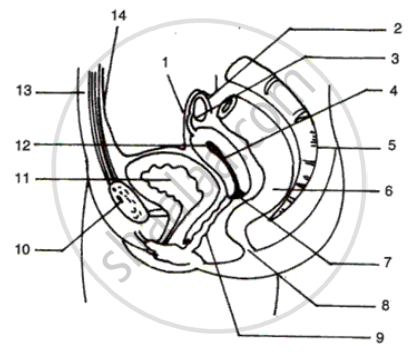Advertisements
Advertisements
Question
Diagram shows the reproductive system of female human beings:
(i) Name the parts numbered 1 to 14.
(ii) Normally, after how many days does an ovary release an egg?
(iii) Where are the sperms released during coitus?
(iv) What is the role of sperms after their ejaculation in vagina?
(v) What is the function of the organ numbered 5?
(vi) What is the gestation period in human?

Solution
(i)
- Fallopian tube
- Funnel like opening
- Ovary
- Uterus
- Sacrum
- Rectum
- Cervix
- Anus
- Vagina
- Front of pelvis
- Bladder
- Muscular uterine wall
- Muscular wall of abdomen
- Peritoneum
(ii) Normally, after 28 days an ovary releases an egg.
(iii) During coitus, sperm are released in the vagina.
(iv) After ejaculation in vagina, sperms undergo fertilization where it fuses with an ovum of female to form zygote.
(v) The function of sacrum is to protect the pelvic organs or reproductive organs of female.
(vi) The gestation period in human is 280 days.
APPEARS IN
RELATED QUESTIONS
For how much time does menstruation last in human females (or women)?
In a flower, the parts that produce male and female gametes are respectively :
(a) sepal and anther
(b) filament and stigma
(c) anther and ovary
(d) stamen and style
When a human female reaches a certain age then vaginal bleeding occurs for a few days after regular time intervals.
(a) What is this process known as (i) in scientific terms, and (ii) in everyday language?
(b) At what approximate age this process starts in human females? When is the human female said to have attained at this stage?
(c) After how much time is this process repeated? For how many days does this process usually last?
(d) What does the onset of this process in human females signify?
(e) At which particular event in the life of a human female does this process stop temporarily but start again?
(f) At which approximate age of human female does this process stop permanently?
Describe the role of the following in human beings:
(i) Seminal vesicles
(ii) Prostate gland
Choose the correct answer:
When pregnancy does not occur, the life of corpus luteum is about _____________
Give two important unique features of the human reproductive system.
Name the Following
What does this abbreviation stand for LH?
______ is a lytic enzyme released by the sperm.
Human eggs are______.
Distinguish between Vasa efferentia and Vasa deferentia.
